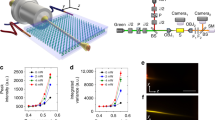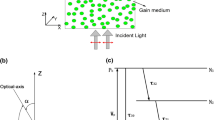Abstract
These are the experimental results describing random lasing in dye-doped chiral nematic liquid crystals. A novel random lasing emission is studied in this article based on the helical domains of dye-doped chiral nematic liquid crystals in oriented and non-oriented cells. Under frequency doubled 532 nm Nd:YAG (yttrium aluminum garnet) laser-pumped optical excitation, we carefully observed and analysed random lasing from dye-doped chiral nematic liquid crystals with wavelength ranges from 600 nm to 620 nm. In addition, the line-width of multi-mode peaks is less than 0.2 nm. The difference between the two random lasing behaviours in the oriented and non-oriented cells arises from the fact that random lasing appearing in the oriented cell results from stronger multiple scattering of light generated by the spiral domains of the liquid crystal molecules. Furthermore, chiral nematic liquid crystal micro-domains with different orientations can induce variation of the diffusion constant, thereby resulting in a decrease or increase in the lasing intensity of the random lasers, and an increase or decrease in their energy thresholds. In addition, a detailed comparison of the two experimental results is also presented in the article, showing the dependence of the lasing threshold and the number of lasing modes on the transport mean free path, the excited area, and the sample size. This process allows us to obtain a random laser by changing the structure of the sample, realising tunable random lasers at low cost.
Similar content being viewed by others
References
V.S. Letokhov, Sov. Phys. J. Exp. Theor. Phys. 26, 835 (1968)
N.M. Lawandy, R.M. Balachandran, A.S.L. Gomes, E. Sauvain, Nature 368, 436 (1994)
H. Cao et al., Phys. Rev. Lett. 82, 2278 (1999)
H.E. Tureci, L. Ge, S. Rotter, A.D. Stone, Science 320, 643 (2008)
H. Cao, J. Phys. A 38, 10497 (2005)
D.S. Wiersma, Nat. Phys. 4, 359 (2008)
O. Zaitsev, L. Deych, J. Opt. 12, 024001 (2010)
S. Ferjani, V. Barna, A. De Luca, C. Versace, G. Strangi, Opt. Lett. 33, 557 (2008)
D.S. Wiersma, S. Cavalieri, Phys. Rev. E 66, 056612 (2002)
D.S. Wiersma, S. Cavalieri, Nature 414, 708 (2001)
D.J. Gardiner et al., Opt. Express 19, 2432 (2011)
V. Barna et al., Opt. Express 14, 2695 (2006)
Y. Takanishi, Y. Ohtsuka, G. Suzaki, S. Nishimura, H. Takezoe, Opt. Express 18, 12909 (2010)
S. Ferjani, A. De Luca, V. Barna, C. Versace, G. Strangi, Opt. Express 17, 2042 (2009)
Q. Song, L. Liu, S. Xiao, X. Zhou, W. Wang, L. Xu, Phys. Rev. Lett. 96, 033902 (2006)
C. Yuen, S.F. Yu, E.S.P. Leong, H.Y. Yang, S.P. Lau, H.H. Hng, IEEE J. Quantum Electron. 41, 970 (2005)
R.K. Thareja, A. Mitra, Appl. Phys. B 71, 181 (2000)
P.C. de Oliveira, J.A. McGreevy, N.M. Lawandy, Opt. Lett. 22, 895 (1997)
Y. Feng, K.I. Ueda, Phys. Rev. A 68, 025803 (2003)
K.L. van der Molen, A.P. Mosk, Ad Lagendijk, Phys. Rev. A 74, 053808 (2006)
J.M. Hvam, J. Appl. Phys. 49, 3124 (1978)
S. Lepri, S. Cavalieri, G.-L. Oppo, D.S. Wierma, Phys. Rev. A 75, 063820 (2007)
S. Redner, A Guide to first-passage Processes (Cambridge University Press, Cambridge, 2001)
L.G. Wang, Y. Huang, Macromolecules 37, 303 (2004)
D.S. Wiersma, Mol. Cryst. Liq. Cryst. 375, 15 (2002)
V.G. Kozlov, V. Bulovic, P.E. Burrows, M. Baldo, V.B. Khalfin, G. Parthasarthy, S.R. Forrest, J. Appl. Phys. 84, 4096 (1998)
A. Tulek, R.C. Polson, Z.V. Vardeny, Nat. Phys. 6, 303 (2010)
T.J. Kippenberg, S.M. Spillane, K.J. Vahalaa, Appl. Phys. Lett. 85, 25 (2004)
M.A. Noginov, I.N. Fowlkes, G. Zhu, J. Novak, Phys. Rev. A 70, 043811 (2004)
H. Cao, Y.G. Zhao, Phys. Rev. B 59, 15107 (1999)
Author information
Authors and Affiliations
Corresponding author
Rights and permissions
About this article
Cite this article
Li, LW., Deng, LG. Random lasing from dye-doped chiral nematic liquid crystals in oriented and non-oriented cells. Eur. Phys. J. B 86, 112 (2013). https://doi.org/10.1140/epjb/e2013-30822-0
Received:
Revised:
Published:
DOI: https://doi.org/10.1140/epjb/e2013-30822-0




